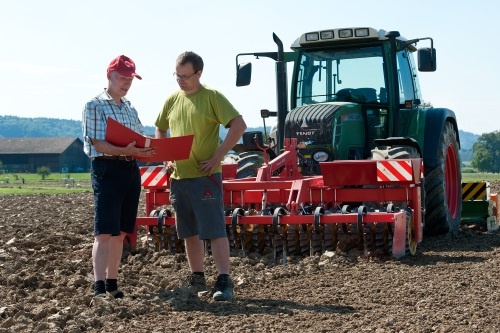
Archive
2,561 posts

There are three methods available for evaluating sustainability at farm level that were developed in Switzerland: RISE, SMART und SALCAsustain. In this article, the three methods are compared by means of a list of criteria and several concrete examples with the aim of making it easier for readers to decide which tool is best suited…

Alternative mowing regimes to favour meadow biodiversity
In Switzerland, biodiversity promotion areas or BPAs (i.e. land under Swiss agri-environment schemes) account for around 15 % of the utilised agricultural area. While the main objective of BPAs is to promote farmland biodiversity, their effectiveness remains limited, in particular as regards the incidence of invertebrates in the lowlands. In this study, the mowing regime…
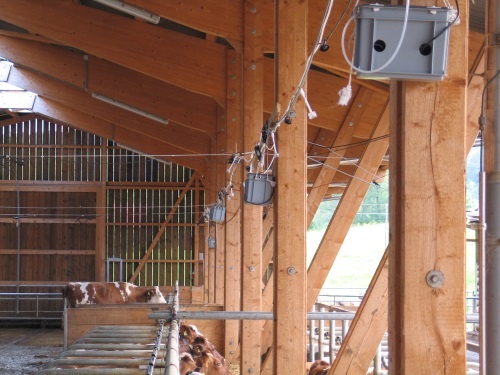
Particulate matter (PM10) emissions from dairy loose housing with outdoor exercise area
To improve the underlying data for emission inventories, particulate matter (PM10) emissions were determined for the most common loose-housing system in Switzerland. Emission measurements were conducted in two out of three seasons (summer, transition period, winter) per farm in six naturally ventilated dairy loose-housing systems comprising cubicles, solid floors and an outdoor exercise area. PM10…
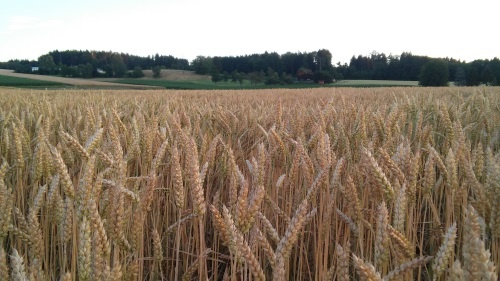
Implications of herbicide-free Extenso wheat cultivation in Switzerland
Various stakeholders are searching for ways to reduce herbicide use on farms. The implications of such measures, however, are often unknown. This article makes use of a bio-economic model to analyse how plant-protection strategies, yields and contribution margins change in Swiss Extenso winter-wheat cultivation if i) neither glyphosate and ii) nor other herbicides are used.…

Swiss private-label branded beef: brand credibility and consumer trust
Ethologically and ecologically sound production methods, brand awareness and brand credibility are all preconditions for the production of high-quality beef and veal. The market research results presented here show that certain consumer segments more frequently consume Swiss private label branded beef if high production standards in terms of animal welfare, ecology and pasture grazing are…

We are what we eat: the market potential of ethnic foods
When people migrate from other cultures to Switzerland, they bring their preferences for the food of their countries of origin. We are what we eat! This article explores the systematic relationship between immigration and food imports for various product categories. The results show that food imports in almost all product categories rise most strongly with…

Impact of type of use on the phosphorus and potassium requirements of grassland in the Swiss Jura
Grazing differs from mowing in its generally less homogeneous use of forage, and above all in its return of nutrients in the excreta of herbivores. The impact of the type of use (four grazings vs four cuts per year) on the phosphorus (P) and potassium (K) requirements of a grassland in the Swiss Jura was…
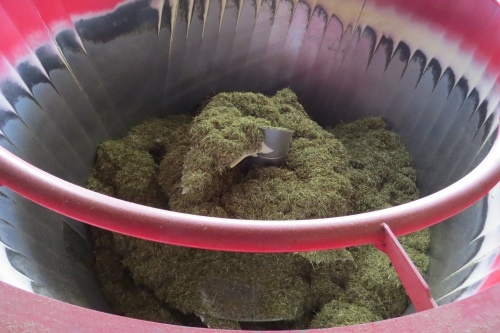
Digestibility of forage in mixed rations
The digestibility of the organic matter (DOM) of a forage, whether estimated in vitro via modelling or determined in vivo via experimentation, is a nutritive value considered in isolation. A ration, however, generally consists of a mixture of different forages and concentrates. This trial – consisting of an in vivo study with wethers – studies…
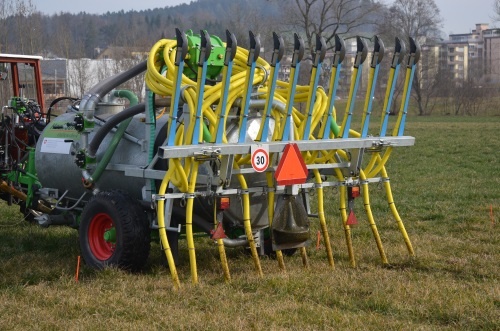
Influence of slurry application technique on yield and nitrogen flows in grassland
Measurement series carried out in Switzerland during different seasons as well as an overview of the literature show that with the use of a trailing hose spreader or trailing shoe spreader, 2–3 kg more nitrogen per hectare ends up in the soil per instance of slurry-spreading than with a broadcast spreader, owing to the escape…

System comparison Hohenrain II: Research combined with knowledge exchange enhances impact on practice
Transferring knowledge between practitioners, researchers, educators and extensionists was a key concern of the ’Optimisation of milk production with fresh grass feeding’ project. The study groups of the participating farms were particularly important. They provided the foundations and data necessary for establishing research questions and worked intensively to implement the new work practices. This triggered…

New cocksfoot variety recommendation: «RGT Lovely» instead of «Lazuly»
From 2015 to 2017, a total of 23 varieties of cocksfoot (Dactylis glomerata L.), 11 of which were new varieties, were tested on seven Agroscope sites as to their suitability for use under Swiss growing conditions. The varieties were evaluated according to yield, feed digestibility, vigour, juvenile development, competitive ability, resistance to leaf diseases, winter-hardiness…
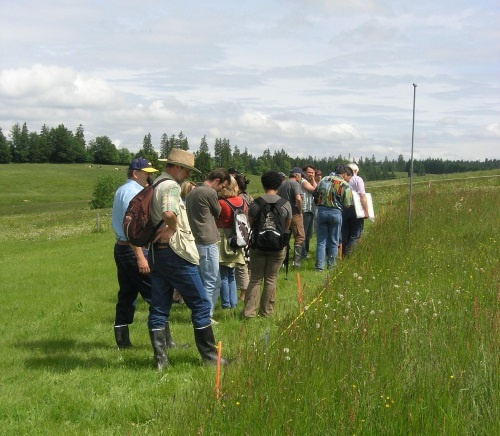
Phosphorus and potassium requirements of a hay meadow of the Swiss Jura dominated by red fescue
Phosphorus (P) and potassium (K) inputs on grassland aim to maintain an appropriate botanical composition and to produce sufficient quantities of forage without harming the environment. Over a 13-year period, eight different levels of P and K fertilisation were applied on a low-intensive permanent grassland in the Swiss Jura. Rising inputs of P (between 0…

Simulation of grass growth and pasture yields with ModVege
Predicting grass growth could be very useful for the management of pastures, or deciding the best time to harvest hay meadows. The ModVege model was tested and improved using a set of 125 situations (meadow × year × management) collected from grassland areas in Switzerland. Comparisons between simulated and measured data show relatively reliable outputs…

Methane emission from grazing dairy cows: comparison of methods
Methane emission from free-ranging ruminants can be measured in different ways. In a study with 13 grazing dairy cows, Agroscope compared two methods. The sulfur hexafluoride (SF6) tracer technique is an established method, but its application is challenging and laborious. Before the measurements started, the cows were equipped with a calibrated permeation tube releasing SF6…

System comparison Hohenrain II: Nutrient and mineral content of conserved forage
From 2014 to 2016, the Hohenrain II Project compared three different grassland-based milk production systems with either full grazing, or with partial grazing with indoor feeding of fresh herbage and reduced or increased concentrate supplementation. From 2013 to 2015, the nutrient and mineral content of the conserved forage (hay, grass silage and artificially dried herbage)…

Life-cycle assessment of pasture- and grassland-based milk production systems
As part of the project ’Optimisation of Grassland-Based Milk Production Systems based on Fresh-Grass Harvesting (Hohenrain II)’, we used the SALCA life-cycle assessment method to compare the environmental impacts of three systems, viz. full-grazing with seasonal calving and two variants of fresh-grass harvesting with differing use of concentrates (< 500 kg/cow/ year and 800–1200 kg/cow/year).…

Milk production: fresh grass with low concentrates pays off
Many Swiss dairy farmers use variable proportions of fresh grass (forage or grazing) and supplementary feed in their production. Which characteristics are economically successful in these fresh grass systems? This question was addressed in the project «Optimisation of grassland- based milk production systems based on forage (Hohenrain II)» conducted on 36 pilot farms over three…

Analysis of value distribution in the dairy sector
The price of milk delivered to industry by dairy farmers has been steadily decreasing over the last 10 years. In response to this situation, a study on «value distribution in the Swiss agro-food supply chains» has analyzed the situation and suggests concrete measures to improve the financial return to farmers. Across all agricultural sectors, prices…

Animal performance with fresh grass feeding
Partial grazing with indoor feeding of fresh grass is an important feeding system for Swiss dairy farms. From 2014 to 2016, three production systems – partial grazing with indoor feeding of fresh grass with reduced (EGKF; 418 kg), and increased concentrate supplementation (EGKFplus; 1161 kg) was compared with full-time grazing with reduced concentrate supplementation (FG;…

Mineral content of herbage
Full grazing or indoor feeding of fresh herbage and partial grazing are common feeding systems for dairy cows in Switzerland. Project Hohenrain II investigated a comparison of three different grassland-based milk production systems, a partial grazing with indoor feeding of fresh grass with reduced and increased concentrate supplementation was compared with the full grazing system…

Project description and quality of fresh grass
Partial grazing with indoor feeding of fresh grass is an important feeding system for Swiss dairy farms. From 2014 to 2016, three production systems – ’partial grazing with indoor feeding of fresh grass with reduced (EGKF, 418 kg) and increased concentrate supplementation (EGKFplus; 1161 kg) was compared with full-time grazing (FG) with reduced concentrate supplementation…

In vivo and in vitro organic matter digestibility determined with the Ankom DaisyII Incubator
A comparison of organic matter digestibility (OMd) determined in vivo and in vitro was conducted with samples of grass, grass silage, hay, and maize silage (n = 20 per feed) from the Agroscope Posieux collection. The in vitro method was carried out with the Ankom «DaisyII» Incubator (Ankom Technology Corp., Fairport, NY, USA). The coefficients…
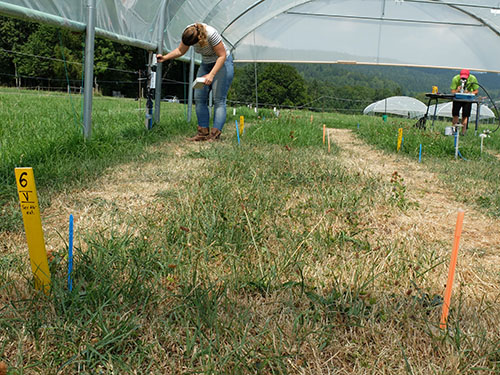
Impact of drought on the functioning of grassland systems
A rainfall manipulation experiment was conducted over a two-year period on two semi-natural grassland sites, in order to determine the effects of drought on both forage production (dry matter and nutritive value) and plant-soil relationships. Water stress simulations were performed with the aid of rainout shelters. Among the nutritional parameters, lignocellulose content (ADF) and water-soluble…
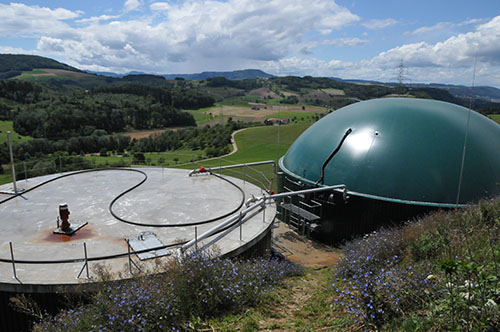
Nitrogen-use efficiency of biogas digestate
The digestion of farmyard manure and other organic materials has become increasingly important in recent years. The digestion process produces biogas (methane), and increases the proportion of easily available nitrogen compounds in the digestate produced. To date, there has been little research on the fertiliser value of digested farmyard manure that is of relevance to…

The contribution of organic farming to reducing plant protection products in Switzerland
If Swiss agriculture was to be converted to 100 % organic management, the number of plant protection products, in terms of active substances, would be reduced from currently 383 to 107 (28 %). Of the remaining 107 substances, 66 are living organisms, 15 pheromones and 26 are substances such as plant extracts, sulphur or copper.…

Reducing PPP inputs due to erosion and runoff
Many Swiss streams exhibit high levels of plant-protection product (PPP) inputs, with erosion and runoff being important entry paths. This article furnishes an overview of measures for reducing PPP inputs into bodies of water from arable land due to erosion, runoff and drainage, and provides an expert-based qualitative evaluation of these measures in terms of…

Biodiversity of cow-dung insects and other pasture dwellers not correlated
The biodiversity of agricultural land is usually measured via indicator species that can be recorded time- and cost-efficiently. Behind this approach lies the seldom-questioned assumption that these groups of organisms are good at reflecting the overall species diversity of a habitat. We tested this assumption by comparing the diversity of cow-dung insects with that of…
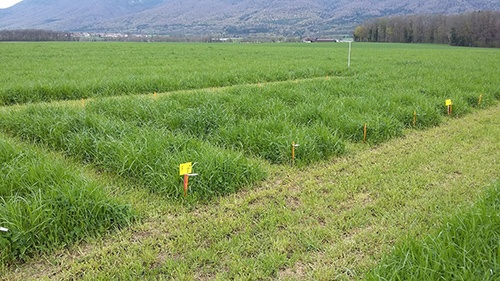
When must intensive grassland be mown?
The optimum harvest date in spring is a problem that divides producers. Is it better to focus on forage quality with an early cut, or quantity with a later harvest? Trials were carried out on mown grasslands from 2014 to 2016 as part of the «Progrès-herbe» [= «Progress Grass»] and «Preparing Forage Production for Climate…

Vegetable protein as an alternative to meat: an assessment for Switzerland
If self-sufficiency in vegetable protein for the human diet is to be increased, the issue should be considered as comprehensively as possible. This study presents a systemic analysis of the situation in Switzerland, showing which protein-rich crops are most suited to sustainable and organic farming, highlighting their nutritional potential, and indicating the necessary steps for…

Reduction of antibiotic use and increase in feeding autonomy in milk production
In dairy farming, the use of antibiotics and the feeding with concentrates are challenged by public opinion and by economic considerations. Antibiotics are used to preserve the health of cattle and the quality of milk, however their use is expensive and can result in antibiotic resistances in human and animal pathogens. It is now urgent…